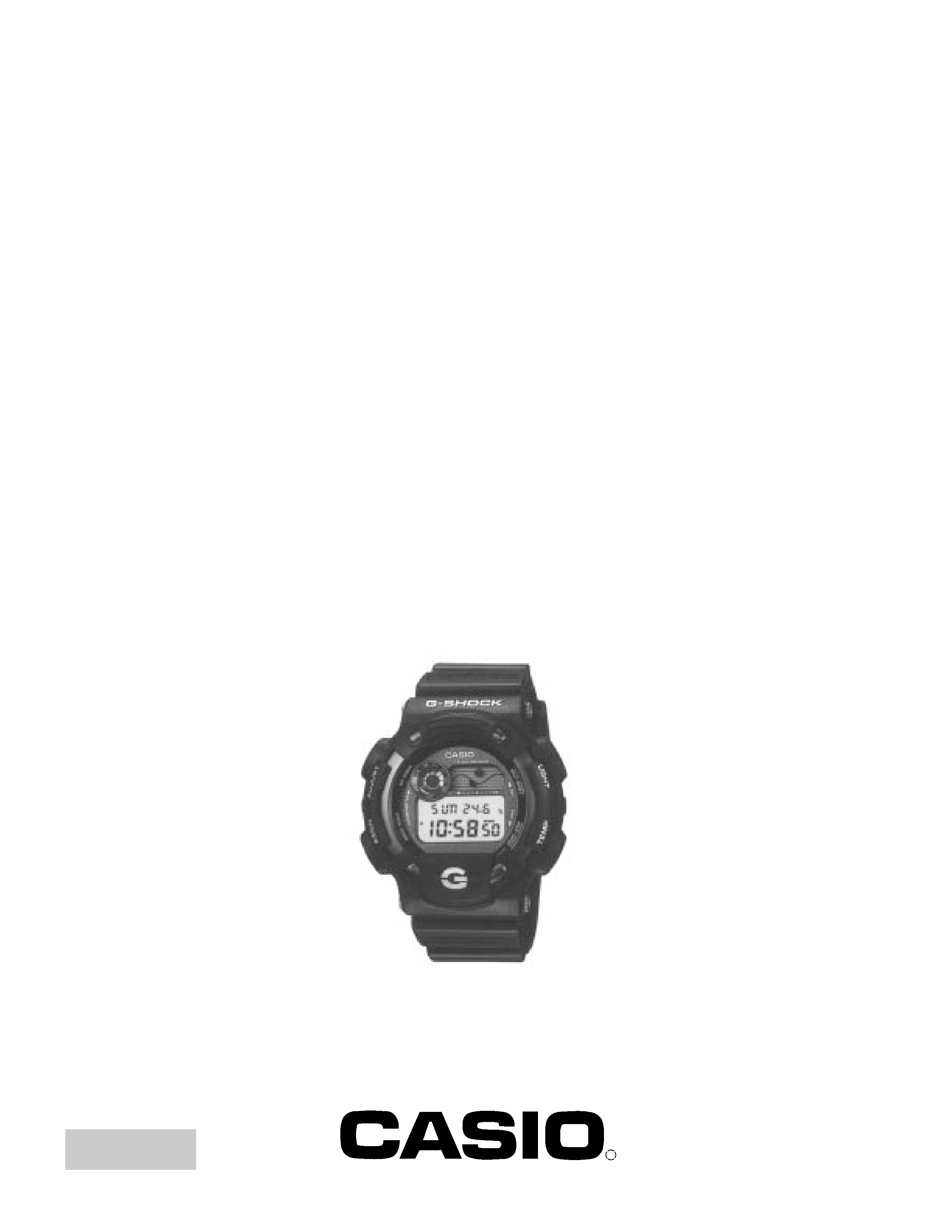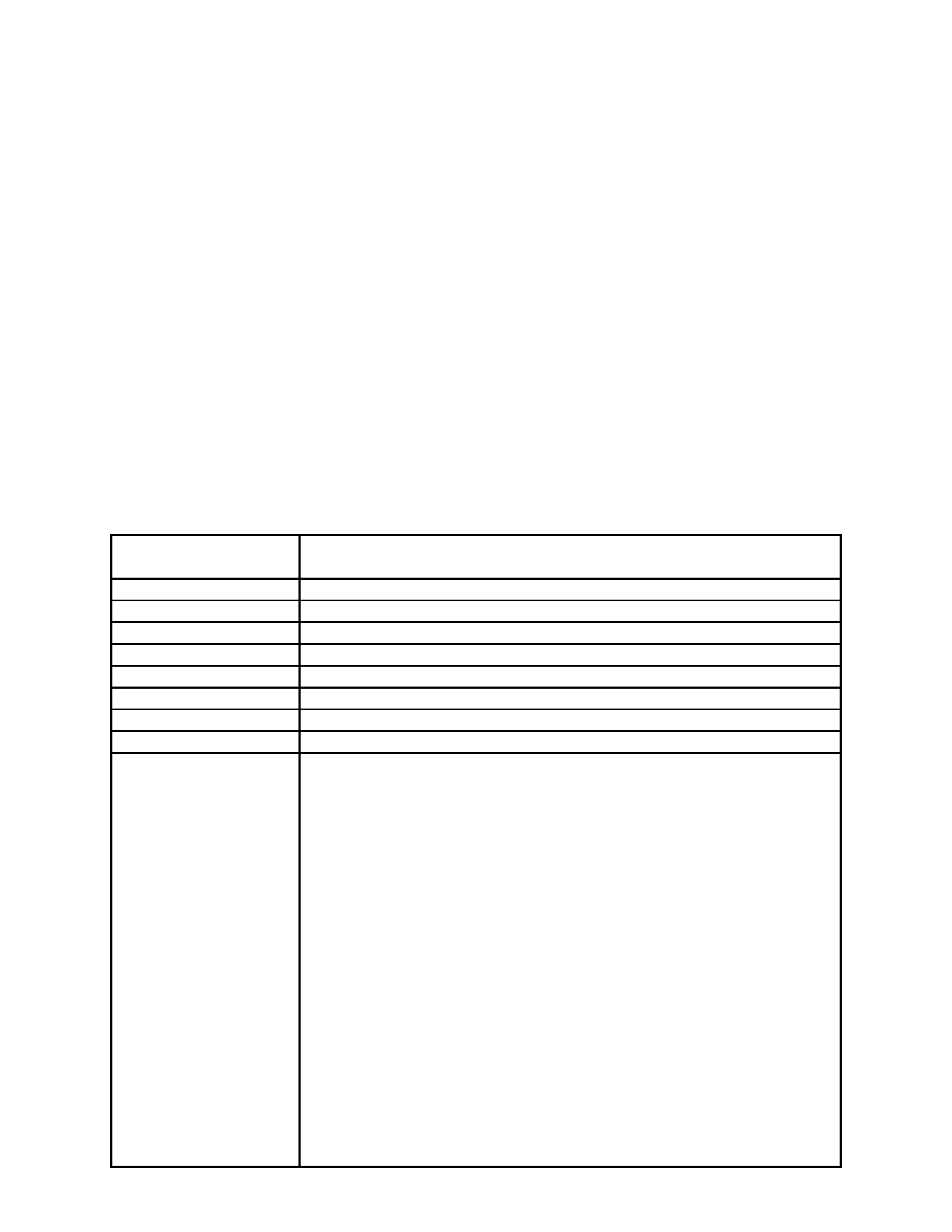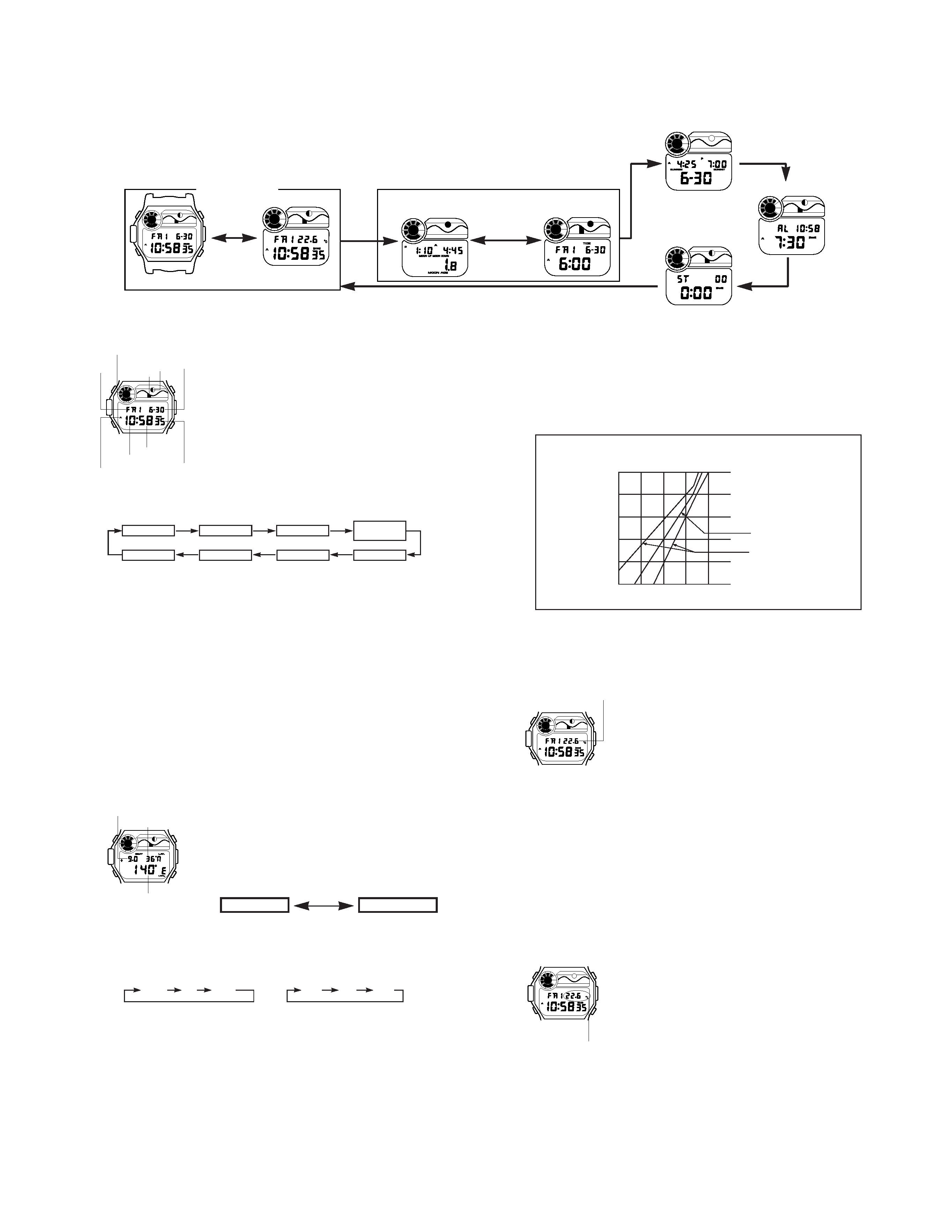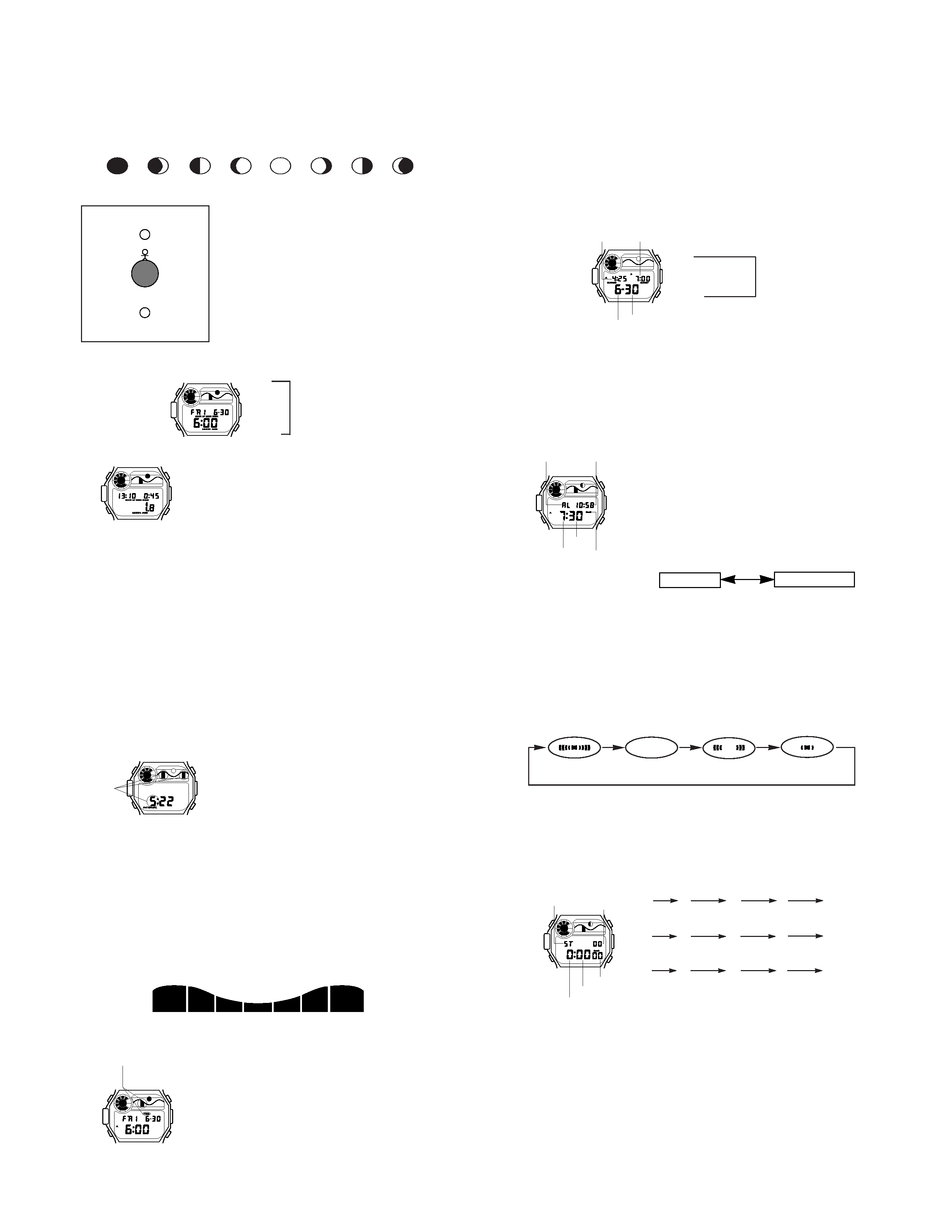
MODULE NO.
R
REF. NO. S/M-571
OCTOBER 1997
QW-1519
DW-8600ZJ
SERVICE MANUAL
& PARTS LIST
(WITHOUT PRICE)
INDEX

-- 1 --
Battery
CR2016
Battery life
Approx. 2 years
Current consumption
2.29
µA maximum
Alarm system
Piezo plate on Cover/Back
Accuracy
±15 sec./month
Accuracy setting system
Capacitor/Trimmer
Accuracy checking
See page 9
Accuracy setting
+0.25 ~ +0.35 sec./day
Functions
· Shock resistant (G-SHOCK)
· Rust resistant
· Electro-luminescent backlight
· Low-temperature resistant (20
°C)
· Thermometer
Measuring range: 20
°C to 60 °C
Display unit: 0.1
°C
· Moon data function
(moon up and moon down time and moon age of the input data)
Moon phase graph
Tide graph
· 1/100 sec. stopwatch
Measuring capacity: 23:59'59.99"
Measuring modes: Net time, split time, 1st-2nd place times
· Daily alarm
· Hourly time signals
· Regular timekeeping: Hr, min, sec, am/pm, mo, date, day
· Auto-calendar (Pre-programmed until the year 2039)
· 12/24-hour formats
Detail
Item
CONTENTS
1. SPECIFICATIONS: QW-1519 ........................................................................ 1
2. OPERATION CHART: QW-1519 ................................................................... 2
3. DRAWINGS: QW-1519 .................................................................................. 5
3-1. BLOCK DIAGRAM ............................................................................................
5
3-2. CHECKING TERMINALS AND COMPONENTS ..............................................
6
3-3. N1~N4, A1~A3 PADS .......................................................................................
6
4. EXPLODED VIEW: QW-1519 ........................................................................ 7
5. PARTS LIST: QW-1519 ................................................................................. 8
6. PRECAUTIONS FOR REPAIR: QW-1519 .................................................... 9
6-1. AC (ALL CLEAR) AND REMOVING OF MODULE ..........................................
9
6-2. ACCURACY CHECKING ..................................................................................
9
6-3. ADJUSTMENT OF THE THERMAL SENSOR ...............................................
10
1. SPECIFICATIONS: QW-1519

-- 2 --
GENERAL GUIDE
TIMEKEEPING FUNCTIONS
There are two different displays in the Timekeeping Mode: a
Timekeeping Display and a Temperature Display. Use D to
switch between them.
· Both the Timekeeping Display and the Temperature Display
show the temperature bar graph.
· Holding down A while the Timekeeping Display is shown
enters the time and date setting mode. Holding down A
while the Temperature Display is shown enters the
temperature calibration mode.
· When in the Timekeeping Mode, press B to illuminate the
display.
To set the time and date
1. Press D to display the timekeeping display (with the month
and date).
2. Hold down A and the seconds digits flash on the display
because they are selected.
3. Press C to change the selection in the following sequence.
4. While the seconds digits are selected (flashing), press D to reset the seconds to "00". If you
press D while the seconds count is in the range of 30 to 59, it is reset to "00" and 1 is added
to the minutes. If the seconds count is in the range of 00 to 29, the minutes count is
unchanged.
5. While any other digits (besides seconds) are selected (flashing), press D to increase the
number or B to decrease it. Holding down either button changes the current selection at high
speed.
· While the 12/24-hour setting is selected, press D to switch between the two formats.
6. After you set the time and date, press A twice to return to the timekeeping display.
· The date can be set within the range of January 1, 1995 to December 31, 2039.
· If you do not operate any button for a few minutes while a selection is flashing, the flashing
stops and the watch goes back to the timekeeping display automatically.
Important
· After you change a setting in the above procedure, the watch needs a bit of time to calculate
certain information. During this calculation, the patterns in the graphic display move at high
speed. Wait until the patterns stop moving before you try to input any further data.
· If you set the current time forward one hour for daylight saving time (summer time), be sure to
also increase the setting for your difference from Greenwich Mean Time (see "TO SET
LOCATION DATA" below). Of course, you should remember to adjust the other way (by
decreasing the difference) when you go back to standard time.
To set the location data
1. Use C to enter the Timekeeping Mode.
2. Press D to display the Timekeeping Display.
3. Holding down A and the seconds digits flash on the display.
4. Press A again to display the location data. The GMT
differential data is flashing because it is selected.
5. Press C to change the selection in the following sequence.
6. While the GMT differential is selected (flashing), press D to
increase the value. Holding down D changes the current
selection at high speed.
7. While Longitude/Latitude is selected (flashing), press D to change the value of longitude or
B to change the value of latitude. Holding down either button changes the corresponding
setting at high speed.
8. After you set the location data, press A to return to the Timekeeping Display.
Important
After you change a setting in the above procedure, the watch needs a bit of time to calculate
certain information. During this calculation, the patterns in the graphic display move at high
speed. Wait until these display stop moving before you try to input any further data.
ABOUT THE BACKLIGHT
· While in the Timekeeping Mode, press B to illuminate the display.
Caution
· The backlight of this watch employs an electro-luminescent (EL) light, which loses its
illuminating power after very long term use.
· Frequent use of the backligfht shortens the battery life.
· The watch emits an audible sound whenever the display is illuminated. This is because the EL
light vibrates slightly when lit. It does not indicate malfunction of the watch.
· Press C to change from mode to mode.
· After you perform an operation in any mode, pressing C returns to the Timekeeping Mode.
Press D
Press C
Press A
Press C
(Timekeeping Display)
(Temperature Display)
Moon Data Mode
Tide Graph Mode
Alarm Mode
Stopwatch Mode
A
C
B
D
Sunrise/Sunset Mode
Timekeeping Mode
A
C
B
D
Tide
graph
Month
and
Date
Minutes
AM indicator
Day of
week
Hour
Seconds
Temperature
graph
Moon
graph
Seconds
Day of week
Date
Month
Year
Hour
Minutes
12/24-Hour
Format
GMT differential
Longitude/Latitude
A
C
B
D
GMT differential
Longitude
Latitude
179
°W
0
°E
180
°E
65
°S0°N
65
°N
< Latitude >
Press D
Press B
< Longitude >
THERMOMETER FUNCTIONS
A built-in temperature sensor measures temperature and shows the measured value on the
display. The thermometer can be calibrated to correct for errors.
Important
Temperature measurements are affected by your body temperature (while you are wearing the
watch), direct sunlight, and moisture. To achieve a more accurate temperature measurement,
remove the watch from your wrist, place it in a well ventilated location out of direct sunlight, and
wipe off all moisture from the case. It takes approximately 20 to 30 minutes for the case of the
watch to reach the actual surrounding temperature.
Accurate temperature measurements cannot be achieved while you are wearing the
watch. The following graph illustrated affects of body temperature on actual
temperature.
Temperature
Temperature measured when watch is worn on wrist
40
°C
30
°C
20
°C
10
°C
0
°C
10
°C20°C30°C 40°C
Approximate
Differences caused by
individual body
temperture or clothing
About Temperature Measurement
Temperature measurements are taken automatically every two minutes, regardless of what
mode the watch is in. You can see the measured values in the Timekeeping Mode's Temperature
Display.
Understanding the temperature display
1. Use C to enter the Timekeeping Mode.
2. Press D to display the Temperature Display.
· Whenever you switch to the Temperature Display, the current
temperature is measured and displayed.
* The display shows " .
°C" if a measured value falls
outside the range of 20
°C to 60°C. The normal display will
return as soon as the temperature returns within the
allowable range.
Calibrating the Temperature Measurement
The temperature sensor of this watch is calibrated at the factory before shipment and further
adjustment is normally not required. If noticeable error is found in the temperature readings
produced by the watch, you can adjust it to correct the error.
Important
Incorrectly calibrating the temperature measurement of this watch can result in incorrect
readings. Carefully read the following before doing anything.
· Compare the readings produced by the watch with those of another reliable, accurate
thermometer.
· If calibration is required, remove the watch from your wrist and wait for 20 or 30 minutes to
give the temperature of the watch time to stabilize.
· Perform the temperature calibration before procedure as quickly as possible to avoid the
temperature of the watch being affected by your body temperature.
· You can also preform temperature calibration underwater, if the water temperature is stable.
To calibrate the temperature
1. Use C to enter the Timekeeping Mode and press D to
display the Temperature Display.
2. Holding down A and the current temperature digits flash.
3. Each press of D increase the displayed temperature by
0.1
°C, and pressing the B decrease it by 0.1°C.
· You can calibrate the temperature within a range of 9.9
°C
to +9.9
°C.
· Press B and D at the same time to rest the temperature
calibration to the factory setting.
4. After calibrating the temperature, press A to return to the
Temperature Display.
A
C
B
D
Current
temperature *
A
C
B
D
Flashes
2. OPERATION CHART: QW-1519

-- 3 --
MOON DATA MODE
Be sure to set the current time and your current location before trying to use the Moon Data
Mode.
The Moon Data Mode display shows the current moon age, as well as moon up and moon down
times. Moon age is indicated both by a value and one of the following graphics.
· The moon up time indicates when the moon will reach
its highest point relative to your current location (upper
transit), while the moon down time indicates when it will
reach its lowest point (lower transit). Note that moon up
and moon down times are accurate up to
±30 minutes.
You can use the key operation below to look up the moon age and the moon up and moon down
times for any date from January 1, 1995 to December 31, 2039.
New Moon Crescent
Moon
Half Moon
First Quarter
Full Moon
Half Moon
Last Quarter
Moon
Location
Earth
Moon
Moon-Down
Moon-UP
A
C
B
D
Back
Forward
Moon time date search
To display the moon up and moon down time for a specific date
1. Use C to enter the Moon Data Mode.
· When you enter the Moon Data Mode from another mode,
the display shows the moon up and moon down times for
the current date (as kept in the Timekeeping Mode).
2. Press D to advance the date or B to move back. Holding
down either button changes the date at high speed.
3. When the date you want is displayed, you will have to wait
for about 2 seconds as the watch performs its internal
calculation before displaying the moon up and moon down
time for that date.
TIDE GRAPH MODE
Before using the Tide Graph Mode, be sure to first carefully set the current time, your current
location, and the lunitidal interval.
About the lunitidal interval
The lunitidal interval is the period from the moon's upper transit (moon up) to high tide. If you
know the lunitidal interval, tide changes can be determined using the moon age. This watch
calculates tide changes according to the current time and the location setting, and displays them
graphically.
To calculate the lunitidal interval
1. Look up the high tide time for the flood tide of the location whose tide changes you want to
know.
2. Use this watch to look up the moon up time that occurs immediately before this time.
3. Subtracting the moon up time from the high tide time produces the lunitidal interval.
To set the lunitidal interval
1. In the Moon Data Mode, hold down A until both sides of the
Tide Graph and hour digits start to flash, as shown below.
· You can also start this procedure by holding down A while
in the Tide Graph Mode.
2. Use C to select the digit whose setting you want to change.
Each press of C moves the flashing to the next digit.
3. Use D to increase the flashing digit or B to decrease it.
Holding down either button changes the setting at high
speed.
4. After you are finished making the lunitidal setting you want,
press A to enter the Tide Graph Mode.
About the Tide Graph Mode
The Tide Graph Mode shows the changing of the tides in graphic form. The graph uses time
(advancing from left to right) as the horizontal axis, and tide change as the vertical axis.
· You can enter the Tide Graph Mode by pressing A while in the Moon Data Mode. Though you
can change the time setting while in the Tide Graph Mode, you cannot change the month or
day setting. To display the tide graph for another date, return to the Moon Graph Mode,
change the date setting, and then enter the Tide Graph Mode again. Also note that you
cannot directly change the month setting in the Moon Data Mode. The month setting changes
automatically as you increase or decrease the day setting.
· The Tidal Graph is also on the display in the Timekeeping Mode, where it indicates the tide for
the current time.
A
C
B
D
Moon Data Mode Data
A
C
B
D
Flashes
High
Ebb
Low
Flood
High
To display the tide graph for a specific time
1. Use C to enter the Moon Data Mode.
· When you enter the Moon Data Mode from another mode,
the display shows the moon up and moon down times for
the current date (as kept in the Timekeeping Mode).
2. Press A to enter the Tide Graph Mode.
· Whenever you enter the Tide Graph Mode, the graph shows
the tide movements for 6:00 am of the current date.
3. Press D to increase the hour or B to decrease it. Holding
down either button changes the hour at high speed.
A
C
B
D
Flashes
SUNRISE/SUNSET FUNCTIONS
Be sure to set the current time and your current location before trying to use Sunrise / Sunset
functions. The Sunrise / Sunset functions tell you the time of sunrise and sunsets for specific
dates.
To display the sunrise and sunset times for a specific date
1. Use C to enter the Sunrise / Sunset Mode.
· When you enter the Sunrise / Sunset Mode for another mode, the display show the sunrise /
sunset data for today's data (as set in the Timekeeping Mode).
2. Press D to advance the date or B to set it back. Holding down either button changes the date
at high speed.
3. When the date you want is displayed, you will have to wait for about 15 seconds as the watch
performs its internal calculation before displaying the sunrise/sunset time for the date.
Notes
· If you think that the watch is not showing the correct information, check the settings of the
watch in the following order: year, difference from GMT, Longitude, Latitude, east/west,
north/south.
· Sunrise and sunset times are for sea level locations. Actual times may differ slightly
depending on your elevation.
· Sunrise and sunset times are correct with a range of 5 minutes at latitudes less than 50, and
10 minutes at latitudes greater than 50.
ALARM FUNCTIONS
When the Daily Alarm is switched on, the alarm sounds for 20
seconds at the preset time each day. Press any button to stop
the alarm after it starts to sound.
When the Hourly Time Signal is switched on, the watch beeps
every hour on the hour.
To set the alarm time
1. Use C to enter the Alarm Mode.
2. Holding down A and the hour digits flash on the display
because they are
selected. At this time the Daily Alarm is
switched on automatically.
3. Press C to change the selection in the following sequence.
A
C
B
D
Sunrise time
Month
Date
Back
Forward
Sunrise/Sunset
data search
Sunset time
Hour
Minutes
A
C
B
D
Mode indicator
Current time
Minutes
Hourly time
signal on
and Alarm
on indicator
Hours
4. Press D to increase the selected digits and B to decrease them. Holding down either button
changes the selection at high speed.
· The format (12-hour and 24-hour) of the alarm time matches the format you select for normal
timekeeping.
· When setting the alarm time you using the 12-hour format, take care of set the time correctly
as morning (A) or afternoon (P).
5. After you set the alarm time, press A to return to the Alarm Mode.
To switch the daily alarm and hourly time signal on and off
Press B while in the Alarm Mode to change the status of the daily alarm and hourly time signal
in the following sequence.
Alarm on indicator / hourly time signal on indicator
To test the alarm
Hold down D while in the Alarm Mode to sound the alarm.
STOPWATCH FUNCTIONS
The Stopwatch Functions let you record elapsed time, split times, and two finishes. The range of
the stopwatch is 23 hours, 59 minutes, 59.99 seconds. Stopwatch functions are available in the
Stopwatch Mode, which you can enter using C.
Both OFF
Daily Alarm only
Hourly Time Signal only
Both ON
A
C
B
D
(a) Elapsed time measurement
DD
D
D
B
Start
Stop
Re-start
Stop
Clear
(b) Split time measurement
DB
B
D
B
Start
Split
Split release
Stop
Clear
(c) Split time and 1st-2nd place times
DB
D
B`
B
Start
Split
Stop
Split release Clear
First runner
finishes.
Second runner
finishes.
Record time of
first runner.
Record time
of second
runner.
Mode indicator
1/100
second
Seconds
Minutes
Hours

-- 4 --
NO.
CITY
THE DIFFERENCE
FROM GMT FOR
STANDARD TIME
LONGITUDE
LATITUDE
1. PAGO PAGO
11 171
°W14°N
2. HONOLULU
10 158
°W21°N
3. ANCHORAGE
9
150
°W61°N
4. NOME
9
165
°W65°N
5. LOS ANGELES
8
118
°W34°N
6. SAN FRANCISCO 8
122
°W38°N
7. LAS VEGAS
8
115
°W36°N
8. VANCOUVER
8
123
°W49°N
9. SEATTLE
8
122
°W48°N
10. DENVER
7
105
°W40°N
11. EL PASO
7
106
°W32°N
12. EDMONTON
7
114
°W54°N
13. CHICAGO
6
88
°W42°N
14. HOUSTON
6
95
°W30°N
NO.
CITY
THE DIFFERENCE
FROM GMT FOR
STANDARD TIME
LONGITUDE
LATITUDE
15. DALLAS
6
97
°W33°N
16. NEW ORLEANS
6
90
°W30°N
17. WINNIPEG
6
97
°W50°N
18. MEXICO CITY
6
99
°W19°N
19. NEW YORK
5
74
°W41°N
20. MONTREAL
5
74
°W45°N
21. DETROIT
5
83
°W42°N
22. MIAMI
5
80
°W26°N
23. BOSTON
5
71
°W42°N
Add 1 hour to the difference time if DST
(Daylight Saving Time) is used. (EX. if difference
of standard time is +2, that of DST is +3.)
North America
Central and South America
Europe
NO.
CITY
THE DIFFERENCE
FROM GMT FOR
STANDARD TIME
LONGITUDE
LATITUDE
1. PANAMA CITY
5
80
°W9°N
2. LIMA
5
77
°W12°S
3. BOGOTA
5
74
°W5°N
4. CARACAS
4
67
°W10°N
5. LA PAZ
4
68
°W17°S
6. SANTIAGO
4
71
°W33°S
7. PORT OF SPAIN
4
61
°W11°N
8. RIO DE JANEIRO 3
43
°W23°S
9. SAO PAULO
3
47
°W24°S
10. BRASILIA
3
48
°W16°S
11. BUENOS AIRES
3
58
°W35°S
12. MONTEVIDEO
3
56
°W35°S
NO.
CITY
THE DIFFERENCE
FROM GMT FOR
STANDARD TIME
LONGITUDE
LATITUDE
Add 1 hour to the difference time if DST
(Daylight Saving Time) is used. (EX. if difference
of standard time is +2, that of DST is +3.)
NO.
CITY
THE DIFFERENCE
FROM GMT FOR
STANDARD TIME
LONGITUDE
LATITUDE
1. AZORES
1
25
°W38°N
2. LONDON
+0
0
°E51°N
3. DUBLIN
+0
6
°W53°N
4. CASABLANCA
+0
8
°W34°N
5. LISBON
+1
9
°W39°N
6. PARIS
+1
2
°E49°N
7. MILAN
+1
9
°E45°N
8. ROME
+1
12
°E42°N
9. MADRID
+1
4
°W40°N
10. AMSTERDAM
+1
5
°E52°N
11. HAMBURG
+1
10
°E54°N
12. FRANKFURT
+1
9
°E50°N
13. VIENNA
+1
16
°E48°N
14. STOCKHOLM
+1
18
°E59°N
NO.
CITY
THE DIFFERENCE
FROM GMT FOR
STANDARD TIME
LONGITUDE
LATITUDE
15. ATHENS
+2
24
°E38°N
16. HELSINKI
+2
25
°E60°N
17. ISTANBUL
+2
29
°E41°N
Add 1 hour to the difference time if DST
(Daylight Saving Time) is used. (EX. if difference
of standard time is +2, that of DST is +3.)
Africa and Middle East
NO.
CITY
THE DIFFERENCE
FROM GMT FOR
STANDARD TIME
LONGITUDE
LATITUDE
1. BEIRUT
+2
35
°E34°N
2. DAMASCUS
+2
36
°E33°N
3. CAPE TOWN
+2
18
°E34°S
4. KUWAIT
+3
48
°E29°N
5. RIYADH
+3
47
°E25°N
6. JEDDAH
+3
39
°E21°N
7. ADEN
+3
45
°E13°N
8. ADDIS ABABA
+3
39
°E9°N
9. NAIROBI
+3
37
°E1°S
10. DUBAI
+4
55
°E25°N
11. ABU DHABI
+4
54
°E24°N
12. MUSCAT
+4
58
°E23°N
13. KARACHI
+5
67
°E25°N
14. PRAIA
1
23
°W15°N
NO.
CITY
THE DIFFERENCE
FROM GMT FOR
STANDARD TIME
LONGITUDE
LATITUDE
15. DAKAR
+0
17
°W15°N
16. ABIDJAN
+0
4
°W5°N
Add 1 hour to the difference time if DST
(Daylight Saving Time) is used. (EX. if difference
of standard time is +2, that of DST is +3.)
Asia and South Pacific
NO.
CITY
THE DIFFERENCE
FROM GMT FOR
STANDARD TIME
LONGITUDE
LATITUDE
1. DHAKA
+6
90
°E24°N
2. BANGKOK
+7
100
°E14°N
3. JAKARTA
+7
107
°E6°S
4. PHNOM-PENH
+7
105
°E12°N
5. HANOI
+7
106
°E21°N
6. VIENTIANE
+7
103
°E18°N
7. HONG KONG
+8
114
°E22°N
8. SINGAPORE
+8
104
°E1°N
9. KUALA LUMPUR +8
102
°E3°N
10. BEIJING
+8
116
°E40°N
11. TAIPEI
+8
122
°E25°N
12. MANILA
+8
121
°E15°N
13. PERTH
+8
116
°E32°N
14. ULAN BATOR
+8
107
°E48°N
15. TOKYO
+9
140
°E36°N
NO.
CITY
THE DIFFERENCE
FROM GMT FOR
STANDARD TIME
LONGITUDE
LATITUDE
16. SEOUL
+9
127
°E38°N
17. PYONGYANG
+9
126
°E39°N
18. SYDNEY
+10 151
°E34°S
19. MELBOURNE
+10 145
°E38°S
20. GUAM
+10 145
°E13°N
21. NOUMEA
+11 166
°E22°S
22. PORT VILA
+11 168
°E18°S
23. WELLINGTON
+12 175
°E41°S
24. CHRISTCHURCH +12 173
°E43°S
25. SUVA
+12 178
°E18°S
26. NAURU ISLAND
+12 166
°E1°S
27. PAPEETE
10 150
°W18°S
Add 1 hour to the difference time if DST
(Daylight Saving Time) is used. (EX. if difference
of standard time is +2, that of DST is +3.)
